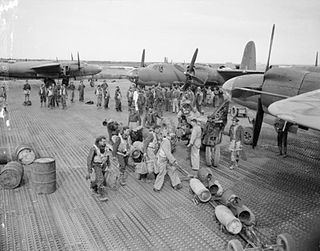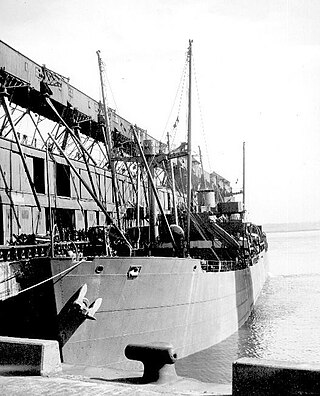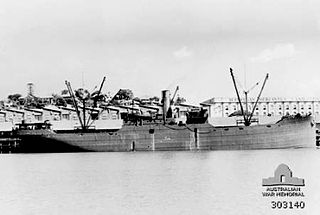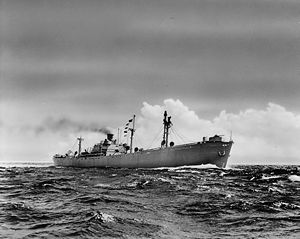I-25 (イ-25) was a B1 type (I-15-class) submarine of the Imperial Japanese Navy that served in World War II, took part in the Attack on Pearl Harbor, and was the only Axis submarine to carry out aerial bombing on the continental United States in World War II, during the so-called Lookout Air Raids, and the shelling of Fort Stevens, both attacks occurring in the state of Oregon.

SS Ohio was an oil tanker built for The Texas Company. The ship was launched on 20 April 1940 at the Sun Shipbuilding & Drydock Co. in Chester, Pennsylvania. The United Kingdom requisitioned it to re-supply the island fortress of Malta during the Second World War.

German submarine U-504 was a Type IXC U-boat of Nazi Germany's Kriegsmarine during World War II. The submarine was laid down on 29 April 1940 at the Deutsche Werft yard in Hamburg as yard number 294, launched on 24 April 1941 and commissioned on 30 July 1941 under the command of Korvettenkapitän Hans-Georg Friedrich "Fritz" Poske. Initially attached to the 4th U-boat Flotilla for training, the U-boat was transferred to the 2nd flotilla on 1 January 1942 for front-line service. She was a member of six wolfpacks.

The Battle of the Caribbean refers to a naval campaign waged during World War II that was part of the Battle of the Atlantic, from 1941 to 1945. German U-boats and Italian submarines attempted to disrupt the Allied supply of oil and other material. They sank shipping in the Caribbean Sea and the Gulf of Mexico and attacked coastal targets in the Antilles. Improved Allied anti-submarine warfare eventually drove the Axis submarines out of the Caribbean region.

The SS James B. Stephens was a 7,176-ton American liberty ship in World War II. She was built by the Oregon Shipbuilding Corporation of Portland, Oregon in 1942 with the hull number 580, and operated by United States Lines, New York City and homeported in Portland. For her role of sailing in dangerous waters, she was armed with one 5in, one 3in and four 20mm guns. She was named for the founder of East Portland.
SS Robin Doncaster was a 7,101 GRT cargo liner that was built in 1940 as a Type C2-S cargo ship by Bethlehem Steel Co, Sparrows Point, Maryland, United States for the United States Maritime Commission (USMC). On completion in April 1941, she was transferred to the Ministry of War Transport (MoWT) and renamed Empire Curlew. In 1942, she was transferred to the USMC, regaining her former name Robin Doncaster. She was rebuilt as a troop transport, and entered service with the War Shipping Administration in January 1944. She was returned to the USMC in April 1946 and was sold to Seas Shipping Co Inc in 1948. In 1957, she was sold to Isbrandtsen Lines and was renamed Flying Gull. Sold to American Export Lines in 1962, she served until she was scrapped in 1968.
Empire Drum was a 7,244 GRT cargo ship that was built in 1941 by William Doxford & Sons Ltd, Sunderland, Co Durham, United Kingdom for the Ministry of War Transport (MoWT). Completed in March 1942, she had a short career, being torpedoed and sunk on 24 April 1942 by U-136.

25 Squadron was a maritime patrol and later medium bomber squadron of the South African Air Force during World War II. It was re-constituted twice between 1951 and 1990 as a medium transport squadron and was finally disbanded in October 1990.
SS Iron Chieftain was a bulk carrier that was built in Scotland in 1937 for the Australian Broken Hill Pty, Ltd (BHP) to carry iron ore. A Japanese submarine sank her by torpedo off the coast of New South Wales in 1942, killing 12 of her crew. Her wreck is protected by the Australian federal Underwater Cultural Heritage Act 2018.

SS Pratt Victory was a United States Victory ship which served in the Pacific Theater of Operations during the last few months of World War II. The ship's US Maritime Commission (MARCOM) designation was VC2-S-AP3, hull number 782 (V-782). SS Pratt Victory was named after Pratt Institute in New York City. It was built in 76 days at the California Shipbuilding Yard (Calship) in Los Angeles, California and was delivered on 9 May 1945.

The SS Brainerd Victory was a Victory-class cargo ship built during World War II.
I-37, originally numbered I-49, was a Japanese Type B1 submarine in service with the Imperial Japanese Navy during World War II. Commissioned in 1943, she made three war patrols, all in the Indian Ocean, during the last of which her crew committed war crimes by massacring the survivors of the merchant ships she sank. Subsequently, converted into a kaiten manned suicide attack torpedo carrier, she was sunk during her first kaiten mission in 1944.

SS Jasper Park was a Park ship freighter, built in 1942. She was sunk by torpedo from German submarine U-177 on 6 July 1943, the first Park ship lost to enemy action. She was completed on 24 September 1942, by the company Davie Shipbuilding in Lauzon, Quebec. Her hull number is 537. Davie Shipbuilding is now called Chantier Davie Canada Inc. The ship was owned by the Park Steamship Company, which was owned by Canada's Federal government. The government had built 400 vessels during World War II. Built as a merchant steamship constructed for Canada’s Merchant Navy in 1942. She was named after Jasper National Park in the Canadian Rockies in the province of Alberta, Canada.

SS Fort Camosun was a coal-burning 7000-ton freighter, built in Victoria, British Columbia, Canada in 1942. In June of 1942, during World War II, she departed Victoria Harbour on her maiden voyage to England with zinc, lead, plywood, timber and other raw materials. On 20 June 1942 the Japanese submarine I-25, under the command of Commander Akiji Tagami, torpedoed the Fort Camosun while she was 70 miles south-southwest of Cape Flattery, just eleven hours out of port, at 11:00pm. The torpedo hit the number two hold on the port side. The crew abandoned ship into the remaining good lifeboats. The submarine then surfaced and used deck guns to fire 18 shells at the Fort Camosun causing further damage to the ship. While badly damaged, the Fort Camosun did not sink, as she was loaded with plywood, timber and other floatable cargo. The crew radioed for help and later an American Flying Fortress located the crew. Later in the day HMCS Edmundston rescued the 31 crew of the sinking Fort Camosun. The Fort Camosun was towed to safety by HMCS Quesnel to Neah Bay. The Fort Camosun was low in the water and was towed with the help of the tugboat Henry Foss from Tacoma, US Navy tug USS Tatnuck and the tugboat Salvage Queen. Fort Camosun reached Neah Bay, later she was towed to Esquimalt B.C. At Esquimalt she was put in dry dock and temporary repairs were made. Fort Camosun repaired took timber to England, via Guantanamo and New York. On the way to England an U-boat attacked her convoy in the Atlantic. As she was passing through the North Channel alone a German aircraft tried to bomb her, but the bomb landed clear of the ship. Later she survived another torpedo attack in the Gulf of Aden.

SS Managua was a Nicaraguan cargo ship that the German submarine U-67 torpedoed on 16 June 1942 in the Straits of Florida while she was travelling from Charleston, South Carolina, United States to Havana, Cuba with a cargo of potash. The ship was built as Glorieta, a Design 1049 ship in 1919, operated by the United States Shipping Board (USSB) until sold to the Munson Steamship Line in 1920 and renamed Munisla. The ship was sold foreign to a Honduran company, Garcia, in 1937 and renamed Neptuno. In 1941 the ship was re-flagged in Nicaragua with the name Managua.

The SS Samoa was a 1,997-ton cargo ship that was able to escape an attack off the coast of California in the early days of World War II. The Samoa was built under a United States Shipping Board (USSB) contract in 1918 as the SS Muerthe, but was launched as the USS Lake Pepin, named after Lake Pepin, by the McDougall Duluth Shipbuilding Company of Duluth, Minnesota measured at 3,600 tons deadweight. She had a triple expansion engine steam engine with 1,250 horsepower (930 kW), a 251-foot (77 m) length, 43.5-foot (13.3 m) beam, a draft of 17 feet 8+1⁄2 inches (5.398 m), a top speed of 9.25 knots. The vessel had a crew of 52, with the hull # 9 and O.N.ID # 21699. The USS Lake Pepin was owned and operated by the United States Navy, commissioned at Montreal, Quebec, Canada on 4 September 1918. For World War I she was fitted with one 3"/50 caliber gun. The Navy put her in Naval Overseas Transportation Service as a coal carrier traveling between the United Kingdom and France as a United States Navy Temporary auxiliary ship. Her coal service ended in May 1919. In June 1919 she returned to the US with a cargo of World War I vehicles and weapons and unused ammunition. The US Navy decommissioned the Lake Pepin on 18 June 1919. In 1923 she was, renamed Samoa purchased and operated by the Hammond Lumber Company. In 1936 she was sold to the Wheeler Logging Company of Portland, Oregon. In February of 1941 she was sold to W. A. Schaefer Company.

SS Coast Trader was built as the cargo ship SS Holyoke Bridge in 1920 by the Submarine Boat Company in Newark, New Jersey. The Coast Trader was torpedoed and sank 35 miles (56 km) south west of Cape Flattery, off the Strait of Juan de Fuca in U.S. state of Washington by the Japanese submarine I-26. Survivors were rescued by schooner Virginia I and HMCS Edmundston. She rests on the ocean floor at.

A. H. Bull Steamship Company was a shipping company and passenger liner service founded in New York City in 1902 by Archibald H. Bull (1848-1920). Service started with shipping between New York and Florida. His fleet of ships then added service to other Eastcoast ports. The company is also often called the Bull Lines and the Bull Steamship Line or A. H. Bull & Company. While founded in New York, Bull soon move its headquarter to Peir 5 in Baltimore, Maryland. Bull Lines main Eastcoast ports were: Baltimore, Charleston, Philadelphia, Tampa and Norfolk, Virginia. Oversea ports: Porto Rico, Antwerp, Bordeaux, Hamburg, Bremen, Copenhagen, and West Africa. Bull Steamship Line supported the US war effort for both World War I and World War II, including the loss of ships.

Sudden & Christenson Company was a shipping and lumber company founded in 1899. Edwin A. Christenson and Charles Sudden of San Francisco, California started the company and shipping line to supply northwest lumber to cities on the east coast, west coast and far east. The ships would return with goods and passengers from the remote ports. Some of the ships also had passenger service on the upper decks. Sudden & Christenson Company and Los Angeles Steamship Company-United American Line started a joint venture called the Arrow Line in 1926. Arrow Line operated from Northwest Pacific Coast Ports and Argentina, Brazil and Uruguay. Sudden & Christenson's San Francisco Headquarters was at 110 Market Street with docks at Pier 15. Sudden & Christenson Company was incorporated in California in 1903. The Sudden & Christenson company dissolved in 1944 and Sudden & Christenson, Inc was founded to pay of the liability of franchise taxes, and operated till dissolved in 1965. Charles Sudden died in 1913 and Edwin Christenson became president with D. Walter Rasor as vice president. The company started with schooners and added steamships. During World War I Sudden & Christenson operated Merchant navy ships for the United States Shipping Board. During World War II Sudden & Christenson was active with charter shipping with the Maritime Commission and War Shipping Administration. Sudden & Christenson had docks in San Francisco, Vancouver, Seattle, Portland, Astoria, Los Angeles and Yokohama, Kobe, Shanghai, Dalian and Tsingtao. Far East ports were a joint venture with the North China Line. In late 1950s came the more cost-effective loading and unloading system, container shipping. The Sudden & Christenson fleet, now aged and on an obsolete system, put the company in decline, closing in 1965.
Sword Line Inc. was a steamship company founded by Charilaos "Charles" G. Poulacos and Abbott Abercrombie in New York City in 1933. Sword Line Inc. had shipping routes from Atlantic ports to and Gulf of Mexico ports. Charilaos "Charles" G. Poulacos and Abbott Abercrombie purchased the ship Eastern Sword in 1932. The Eastern Sword was a 3,785-ton cargo ship built in 1920 at the Uraga Dry Dock Co. Ltd, at Uraga, Japan. The ship sank after being hit by a torpedo from German submarine U-162 on May 4, 1942 twelve miles (19 km) off the coast of Georgetown, Guyana. The Eastern Sword had a crew of 38 and only 13 survived the attack. Sword Line Inc. was active in supporting the World War II effort.













